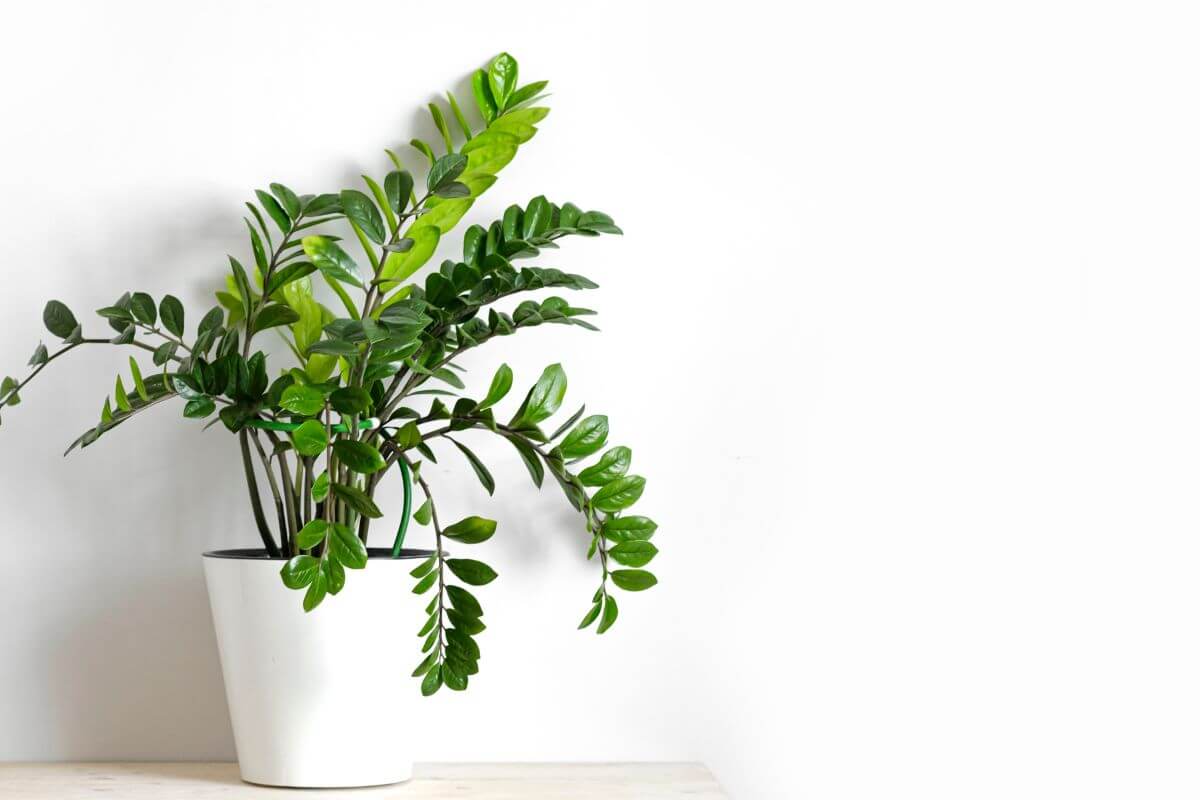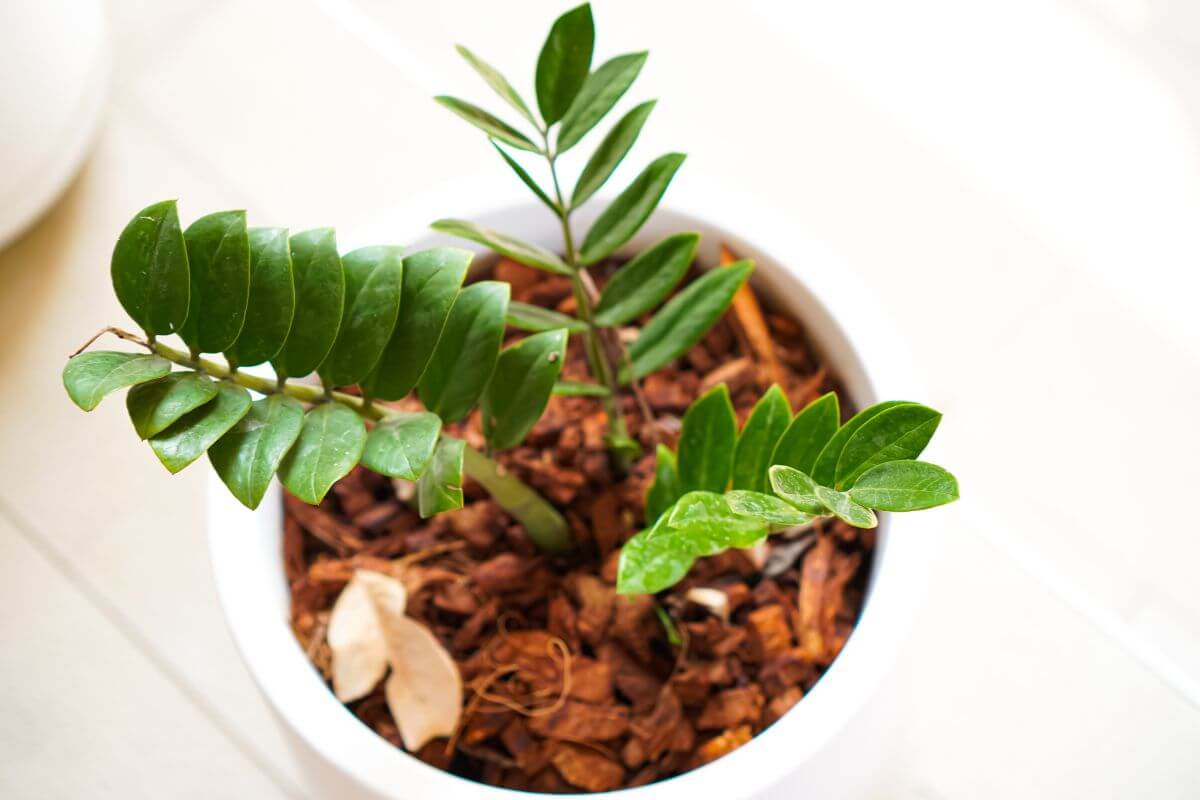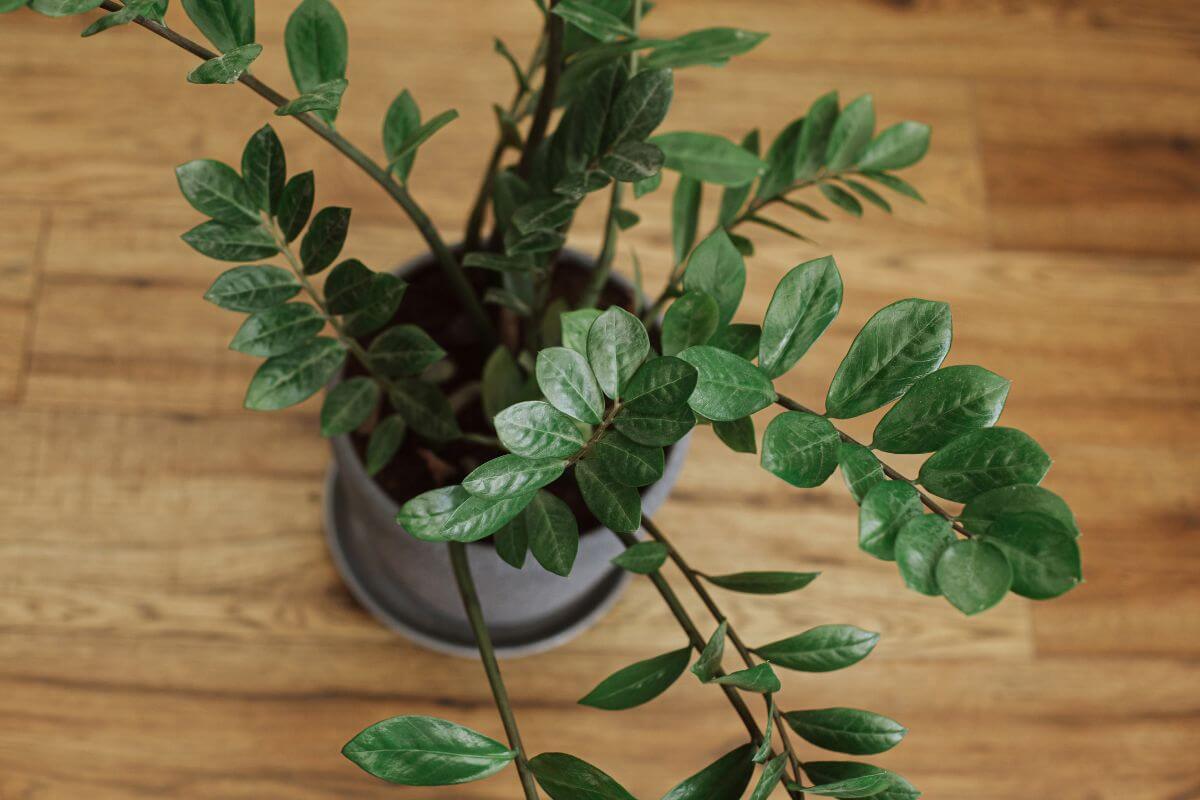If you are looking for a low-maintenance houseplant, the ZZ plant is a popular one growing in many households and office buildings. ZZ plant care is simple, so this tropical perennial is often chosen to liven up its surrounding environment.
The ZZ plant (Zamioculcas Zamiifolia) is also referred to as the Zanzibar Gem. The shiny, dark green, oval-shaped leaves make it a beautiful addition to indoor and outdoor gardens.
Your guests may even think your ZZ is an artificial plant because the leaves have a waxy look to them. Even those without a green thumb can grow this indoor plant successfully.
This article discusses everything about the ZZ plant and how to care for it.
- Read More Care Guides for Houseplants
ZZ Plant Overview

The ZZ plant is native to Eastern Africa where drought is common. This plant has been around forever, but only became internationally known in 1996 when Dutch nurseries working in South Africa began international distribution.
This attractive deep green houseplant can survive even the most neglectful owner, making it incredibly popular among houseplant enthusiasts. It also has been shown to belong to a group of houseplants that act as air purifiers, removing toxins from the air.
A member of the Aracae family, it will tolerate drought and low light conditions. That helps make it perfect for any room in the house or office, such as a lobby or waiting room, that doesn’t benefit from large sunny windows or direct sunlight.
This is a slow-growing plant that can, reach two to three feet tall. This plant also does not tend to outgrow its pot quickly.
With adequate light, and a good soaking every couple of weeks, your ZZ will thrive. The leaves may require occasional dusting as the ZZ is known for its glossy, deep green leaves.
After a while, the leaves may appear dull due to dust build up. Avoid using a spray-on leaf shine, because it will most probably clog the pores of the leaf. It’s better to gently wipe leaves with a damp soft cloth to return its natural shine.
There are a few common names for it: ZZ Plant, Zanzibar Gem, Zuzu Plant Aroid Palm, Money Tree, Eternity Plant, Golden Tree and more. There are also some popular varieties:
- Dwarf ZZ or “Zamicro” – This is a short version that will grow to be about two feet tall.
- Lucky Classic ZZ – This variety has rounder leaves that appear less pointed.
- Raven ZZ – While new leaves will appear light green in color, mature leaves are crow black.
- Zamioculcas Zamiifolia Variegated – This version has green foliage that is variegated with yellow and white. If it does not receive adequate light, the variegation may fade.
ZZ Plant Care Guide
Soil for the ZZ Plant
ZZ will do well in regular potting soil mix as long as it is well-draining. Choose a pot with a sufficient number of draining holes and add some sand or perlite to your soil mixture to get well-draining soil.
Light for the ZZ Plant

ZZ is very tolerant of a wide variety of levels of light conditions, making it a perfect houseplant. It likes bright, indirect light, but will also continue to grow with fluorescent lights. Natural light is of course preferred.
If they receive insufficient light, they will begin to look leggy. Direct light should be avoided to prevent scorching the plant’s leaves. Rotate your plant occasionally, so it receives light from all angles.
Water and Humidity for the ZZ Plant
The ZZ grows from thick tubular rhizomes underground, making them exceptionally drought tolerant. Thus, infrequent watering won’t be a problem.
They should only be watered when the soil bed has dried out completely, perhaps once a week or once every two weeks, depending on the climate you live in.
If you forget to water, don’t worry. These plants can survive up to several months without water. It is preferable to underwater this plant, as opposed to overwatering it.
You may water a bit more often if your ZZ has access to brighter light or it’s the summer months when it’s warmer. In lower light conditions, you will most likely need to water less often.
Average humidity is fine. ZZ does not require a humid environment. However, if your home is in a climate, consider getting a humidifier for your plants.
Another option is placing your ZZ pot on a water tray to help it a bit. Fill a tray with pebbles or stones and then add water. The plant or container should not come into contact with standing water, but should sit above it. If the pot and soil are in contact with the water, it’ll be like overwatering.
Should you go on vacation for a couple of weeks, don’t worry because a still healthy ZZ will be there to greet you when you get home.
Temperature for the ZZ Plant

ZZ plants do not tolerate the cold well, so they should not be exposed to temperatures that fall below 45° Fahrenheit. Household temperatures are usually fine for a ZZ.
Avoid placing them near doors and windows where they will be at risk for drafts, or in cold corners in your home.
Fertilization for the ZZ Plant
The ZZ does not require regular fertilization in order to grow or survive. If you want to give your plant a treat, you can fertilize it once or twice during its growing season.
Use a standard 20-20-20 indoor plant fertilizer that is liquid soluble and dilute it with water to half-strength. This will contribute to keeping your plant in good health.
Pruning and Repotting the ZZ Plant

If the branches begin to intrude on your space, simply prune them. These plants may flower during the period from mid-summer to the beginning of fall. Its flowers are quite small, and the ZZ is much more famous for its foliage.
Repotting a ZZ should be performed when it outgrows its current pot. The plant will indicate that it needs a new pot because the rhizomes under the surface of the soil, will press against the sides of the container, and may even warp its shape.
Repotting should be carried out in the springtime or summer. The plants are better equipped to be disturbed during their active growing season. Again, make sure the new pot you select has a good number of drainage holes.
When you pot the ZZ plant, don’t plant the rhizome too deeply. Fill the pot so there’s a thin layer of soil over the rhizome, while also letting a small part of the root bulb exposed. It will help with preventing stem rot.
Propagating the ZZ Plant
A ZZ can be propagated either through plant division or with leaf cuttings. Division will be the simplest choice for creating new ZZ plants to enjoy or to gift to others. When you repot your ZZ plant, you can separate the underground rhizomes and plant them in separate pots.
ZZ plants can also be propagated using leaf cuttings. Cut a portion of the stem with at least two leaves and plant it directly in well-draining potting soil.
Place the cutting in a warm location that receives bright light, but not direct sunlight during the daytime. This procedure will usually take longer than a rhizome division.
You will most likely note new rhizome growth after six to nine months.
Read the full How to Propagate ZZ Plant guide.
ZZ Plant Toxicity and Pets
The ZZ is quite famous for rumors that circulated approximately ten years ago indicating that the ZZ was so terribly toxic that it caused cancer and needed to be avoided. This was found to be totally false, but it is toxic.
However, all ZZ plant parts are mildly toxic to humans, cats, and dogs because the entire plant contains calcium oxalate crystals. These crystals have sharp edges that will irritate the part of the body that they come into contact with.
Calcium oxalate usually irritates the digestive tract and the mouth. Should your pet vomit, drool excessively, or seem to have difficulty breathing, take it to your veterinarian immediately and inform the vet that you suspect ZZ plant poisoning.
Poisoning signs may include:
- Vomiting
- Excessive drooling
- Mouth pain or discomfort
- Foaming at the mouth
- Mouth, eyes, lips, or an irritated tongue
- Your pet paws at its mouth or oral cavity.
- Difficulty breathing
- Difficulty when swallowing
- Loss of appetite
- Diarrhea
- Tremors
ZZ Plant Pests, Diseases, and Problems

ZZ is very resistant to pests and will generally remain pest-free. Should you notice pests such as aphids, gnats, mealybugs, mites, or whiteflies, treat your plant immediately by spraying diluted neem oil once a week and wiping down the plant leaves.
Common stress symptoms and how to hopefully revive the ZZ plant include:
- Wilting plant with a dry soil bed. The plant needs to be watered.
- Wrinkled leaves. The plant is underwatered.
- A bending ZZ plant. This may be due to a lack of sufficient light.
- Mushy roots indicate root rot and overwatering.
- A yellow ZZ plant may indicate root rot and insufficient drainage. Check out the drainage holes and throw out extra water. Repot your plant with one-third of river sand in your potting mix.
- Yellowing leaves may also include lack of nutrients, in which case you can add some fertilizer every two weeks.
- Yellow leaves also indicate it may be rootbound. If the plant is strangling itself because the roots circle around the inside of a pot that is too small, it will need to be repotted. Untangle the roots and trim the longer ones. Roots should not measure more than three centimeters in length.
If your ZZ has sap drops on its leaves, not to worry. This is normal and indicates a well-watered, happy plant.
ZZ Plant Care Final Thoughts
Whether you have your own urban jungle or just want to dress up a room with some greenery, the ZZ is a terrific houseplant. While it will probably be too tall for a table-top or shelf, it looks great and complements your decor when set to the side of furniture.
The ZZ plant is a resilient, beautiful plant that has found its way into the homes and hearts of many.
For more care and grow advice on plants, check these guides out:
ZZ Plant Care FAQs
Does the ZZ plant need sunlight?
Yes, the ZZ plant needs sunlight to grow. It does best if given 4-6 hours of direct sun per day, but it’s not needed. The ZZ plant grows best in bright, indirect light.
Can the ZZ plant kill you?
It’s not likely that the ZZ plant will kill you. The ZZ plant is a mildly toxic plant that can cause discomfort to humans, including nausea and vomiting if consumed in large amounts. It’s best to keep children away from the ZZ plant to prevent ingestion. However, it’s more
Is a ZZ plant good for the bedroom?
Absolutely, the ZZ plant can be good for your bedroom. It’s an air cleaning plant, so it helps remove toxins from the air. Plus, it adds color and life to any space.
Do ZZ plants clean the air?
Yes, ZZ plants are great at cleaning the air. A NASA Clean Air Study showed that the ZZ Plant and other houseplants improve air quality.
Should a ZZ plant bulb be exposed?
Yes, leaving the ZZ plant bulb a little exposed can help prevent stem rot. Don’t plant the rhizome too deep. A thin layer of soil over the rhizome is best.
When should you repot a ZZ plant?
ZZ plants should be repotted every 1-2 years when it’s outgrown the current pot or you see that the ZZ has root rot. Choose a new pot that’s one size larger that the current pot. Also make sure there are drainage holes to make sure water can drain.
Is the ZZ plant good luck?
The ZZ plant has the nicknames “Fortune Tree” and “Eternity Plant,” because some people believe the ZZ brings good luck and growth wherever it is.


